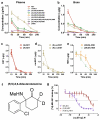NMDAR inhibition-independent antidepressant actions of ketamine metabolites
- PMID: 27144355
- PMCID: PMC4922311
- DOI: 10.1038/nature17998
NMDAR inhibition-independent antidepressant actions of ketamine metabolites
Abstract
Major depressive disorder affects around 16 per cent of the world population at some point in their lives. Despite the availability of numerous monoaminergic-based antidepressants, most patients require several weeks, if not months, to respond to these treatments, and many patients never attain sustained remission of their symptoms. The non-competitive, glutamatergic NMDAR (N-methyl-d-aspartate receptor) antagonist (R,S)-ketamine exerts rapid and sustained antidepressant effects after a single dose in patients with depression, but its use is associated with undesirable side effects. Here we show that the metabolism of (R,S)-ketamine to (2S,6S;2R,6R)-hydroxynorketamine (HNK) is essential for its antidepressant effects, and that the (2R,6R)-HNK enantiomer exerts behavioural, electroencephalographic, electrophysiological and cellular antidepressant-related actions in mice. These antidepressant actions are independent of NMDAR inhibition but involve early and sustained activation of AMPARs (α-amino-3-hydroxy-5-methyl-4-isoxazole propionic acid receptors). We also establish that (2R,6R)-HNK lacks ketamine-related side effects. Our data implicate a novel mechanism underlying the antidepressant properties of (R,S)-ketamine and have relevance for the development of next-generation, rapid-acting antidepressants.
Figures














Comment in
-
Depression: Ketamine steps out of the darkness.Nature. 2016 May 26;533(7604):477-8. doi: 10.1038/nature17897. Epub 2016 May 4. Nature. 2016. PMID: 27144350 Free PMC article.
-
The antidepressant effect of ketamine: Mediated by AMPA receptors?Eur Neuropsychopharmacol. 2016 Oct;26(10):1692-3. doi: 10.1016/j.euroneuro.2016.08.002. Epub 2016 Aug 20. Eur Neuropsychopharmacol. 2016. PMID: 27550426 No abstract available.
-
Antidepressant Actions of Ketamine Versus Hydroxynorketamine.Biol Psychiatry. 2017 Apr 15;81(8):e65-e67. doi: 10.1016/j.biopsych.2016.06.029. Epub 2016 Sep 28. Biol Psychiatry. 2017. PMID: 27817845 No abstract available.
-
Reply to: Antidepressant Actions of Ketamine Versus Hydroxynorketamine.Biol Psychiatry. 2017 Apr 15;81(8):e69-e71. doi: 10.1016/j.biopsych.2016.08.039. Epub 2016 Sep 30. Biol Psychiatry. 2017. PMID: 27817846 Free PMC article. No abstract available.
-
Party drug's power to fight depression puzzles scientists.Nature. 2017 May 2;545(7652):17. doi: 10.1038/545017a. Nature. 2017. PMID: 28470222 No abstract available.
References
-
- Kessler RC, et al. The epidemiology of major depressive disorder: results from the National Comorbidity Survey Replication (NCS-R) JAMA. 2003;289:3095–3105. - PubMed
-
- Trivedi MH, et al. Evaluation of outcomes with citalopram for depression using measurement-based care in STAR*D: implications for clinical practice. Am J Psychiatry. 2006;163:28–40. - PubMed
-
- Rush AJ, et al. Acute and longer-term outcomes in depressed outpatients requiring one or several treatment steps: a STAR*D report. Am J Psychiatry. 2006;163:1905–1917. - PubMed
-
- Zarate CA, Jr., et al. A randomized trial of an N-methyl-D-aspartate antagonist in treatment-resistant major depression. Archives of general psychiatry. 2006;63:856–864. - PubMed
-
- Berman RM, et al. Antidepressant effects of ketamine in depressed patients. Biol Psychiatry. 2000;47:351–354. - PubMed
References (Methods)
-
- Chiu J, et al. Chronic ethanol exposure alters MK-801 binding sites in the cerebral cortex of the near-term fetal guinea pig. Alcohol. 1999;17:215–221. - PubMed
Publication types
MeSH terms
Substances
Grants and funding
LinkOut - more resources
Full Text Sources
Other Literature Sources
Medical

